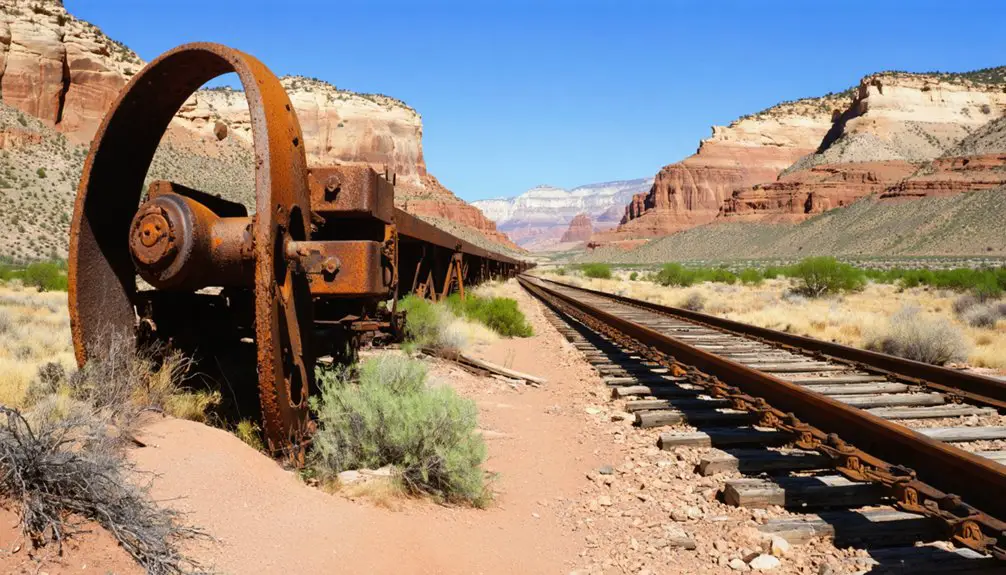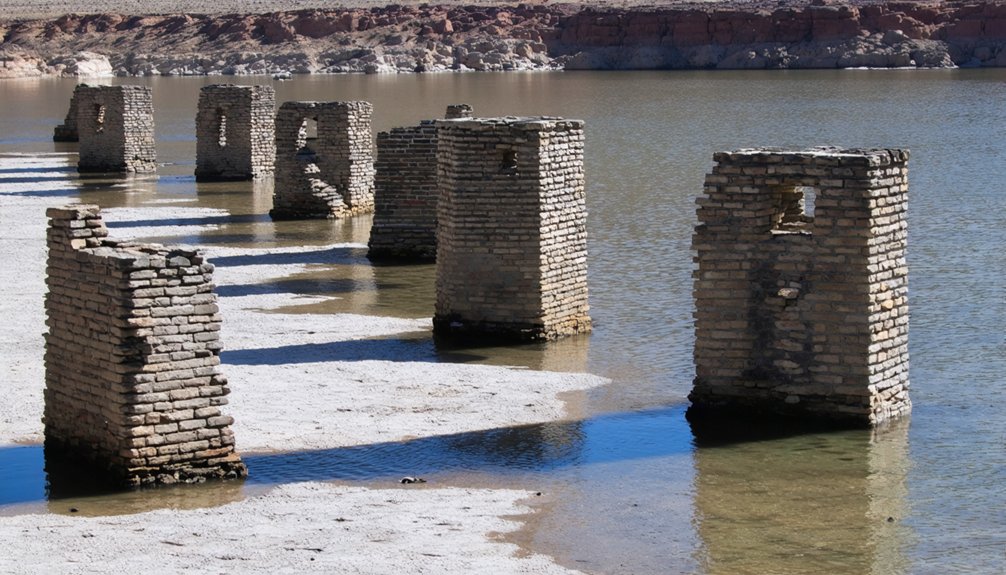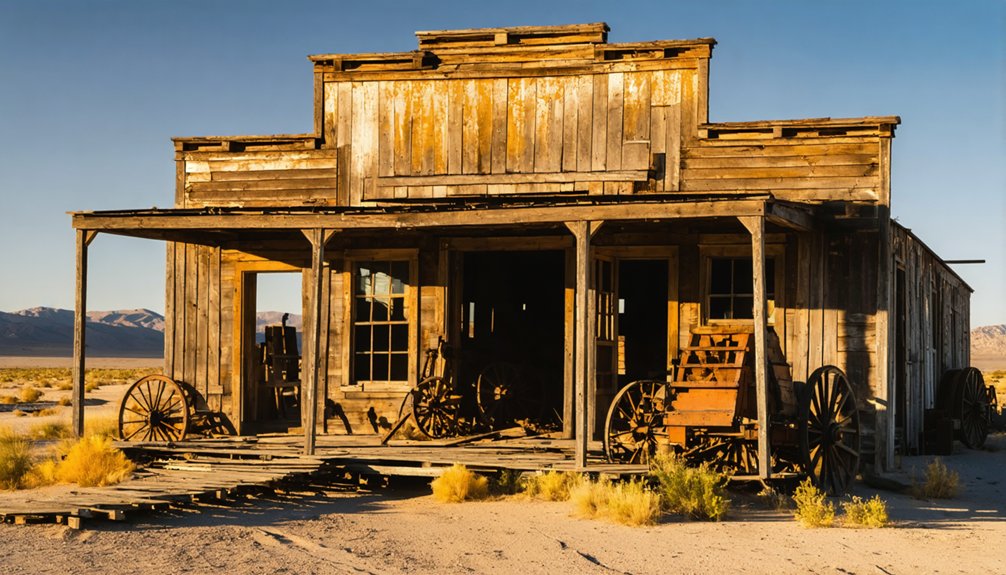You’ll find Colorado City’s remains beneath Lake Mead‘s waters, where this once-bustling mining settlement served Nevada’s steamboat and ore processing needs from 1861 to 1935. The town’s strategic location at El Dorado Canyon’s mouth made it essential for mineral transport and processing through its two steam-powered mills. When Hoover Dam created Lake Mead, the settlement vanished underwater, though dropping water levels occasionally reveal fascinating glimpses of its foundations and structures.
Key Takeaways
- Colorado City was established in 1861 as a mining settlement near the Colorado River, initially part of New Mexico Territory.
- The settlement featured two significant steam-powered stamp mills, the Colorado Mill and New Era Mill, for processing local ore.
- Located at El Dorado Canyon’s mouth, the town served as an important steamboat landing for mining operations.
- The town changed territorial jurisdiction multiple times, moving from New Mexico to Arizona (1863) and finally to Nevada (1867).
- The community relied heavily on river transportation for freight and commerce before the development of railroad infrastructure.
The Birth of a Mining Settlement
When prospectors discovered mineral deposits near the Colorado River in 1861, Colorado City emerged as an essential mining settlement in what was then New Mexico Territory.
You’ll find that this mining camp strategically positioned itself at the mouth of El Dorado Canyon, serving as a crucial steamboat landing for transporting mining goods and supplies.
The settlement’s growth reflected the dynamic nature of the American frontier, as you’d see the town change territorial hands from New Mexico to Arizona in 1863, and finally to Nevada’s Lincoln County by 1867. Due to similar names causing confusion, proper disambiguation of locations became necessary when referencing Colorado City.
Like the harsh mountain conditions that challenged early Colorado prospectors, the establishment faced severe weather and isolation, yet its prime location at the confluence of the Colorado River and El Dorado Canyon made it an ideal logistical hub, attracting merchants, laborers, and support services that transformed the modest mining camp into a bustling riverside settlement.
Life Along the Colorado River
Life along the Colorado River posed unique challenges and opportunities for Colorado City’s inhabitants. You’d have found a vibrant mix of cultures adapting to the harsh desert climate, where survival depended on understanding the river’s seasonal patterns.
River ecosystems provided essential resources, while steamboats connected the settlement to distant markets through regular transport services. The region’s mean elevation 5,500 feet created distinct environmental conditions that settlers had to navigate. The Indigenous peoples had established water distribution systems as early as 600 CE, laying groundwork for future settlement patterns.
Daily life revolved around the river’s rhythms, shaping cultural practices from Indigenous irrigation techniques to settler farming methods. You’d have witnessed a community balancing subsistence agriculture with mining activities, all while maneuvering complex water rights.
The river landing served as a crucial hub, where traders, miners, and farmers converged to exchange goods and information.
Despite periodic floods and droughts, the community’s resilience showed in their adaptive water management strategies and diverse economic activities.
Mining Operations and Infrastructure
You’ll find evidence of Colorado City’s mining prowess in its two steam-powered stamp mills: the relocated Colorado Mill and the newer New Era Mill, which crushed precious metal ores using locally sourced wood for fuel.
Similar to Ghost Burger’s fame at the Pioneer Saloon in nearby Goodsprings, these historic mills became local landmarks that drew visitors to the area.
The mills’ strategic placement near the Colorado River allowed for efficient ore processing and direct loading onto steamboats, creating an integrated transport system for mining exports.
Gold extraction methods centered on these riverside facilities, where workers processed ore from the surrounding Eldorado Canyon before shipping it downstream via the Colorado River’s extensive steamboat network.
Stamp Mills and Processing
Two prominent stamp mills established in 1866 formed the industrial heart of Colorado City’s mining operations. The Old Colorado Mill, relocated from El Dorado City, operated alongside the newly constructed New Era Mill, both powered by steam engines fueled by the area’s abundant wood supply.
Raw ore was processed through these facilities to increase shipping value significantly. The stamp mill technology employed heavy iron or wooden stamps, each weighing up to a ton, to crush valuable ore. You’d find ore processing methods that included amalgamation with mercury or cyanide treatment to extract precious metals.
The mills processed around 100 tons of ore daily, requiring 150-200 gallons of water per stamp per hour. These facilities were similar to nearly 400 stamp mills that operated throughout California’s Gold Rush region by 1875. While these mills once dominated western mining, they’re now submerged beneath Lake Mohave’s waters, silent testimony to Colorado City’s industrial past.
Only archaeological records and historical documentation preserve their legacy.
River Transport Logistics
Before Hoover Dam’s construction transformed the landscape, the Colorado River served as an essential transportation artery for Colorado City’s mining operations.
You’ll find evidence of extensive river navigation infrastructure that supported steamboats and barges traveling up to 350 miles from the Gulf of California. These vessels carried heavy mining equipment, ore, and supplies through remote canyon regions during the 1860s through early 1900s.
The freight efficiency of this water-based transport system was crucial before rail development. The area’s mining activities expanded significantly after the Comstock Lode discovery in 1859, increasing demand for river transportation.
Like the sixteen smelters that operated outside Eureka, Colorado City developed extensive processing facilities along its riverfront.
You can still spot remnants of the docks, wharves, and warehouses that once facilitated the transfer of mining cargo. The U.S. Army’s 1867 outpost at Eldorado Canyon protected these significant supply routes, highlighting their strategic importance.
This river transport network later integrated with the Nevada Copper Belt Railroad, expanding the region’s mining capabilities.
Gold Extraction Methods
Gold extraction in Colorado City initially centered on placer mining in 1859, where prospectors recovered gold from local streambeds near Idaho Springs.
Though operations quickly expanded to include hardrock mining of gold-bearing veins within gneiss and granodiorite formations. You’ll find that early processing relied heavily on stamp mills, with Nevadaville operating 175 ore stamps by the early 1860s.
When miners encountered deeper sulfide ores, they couldn’t efficiently extract gold using mercury amalgamation.
Everything changed in 1868 when Nathaniel P. Hill introduced smelting in Black Hawk. This breakthrough allowed miners to process complex sulfide ores that had previously resisted extraction, leading to the district’s impressive yield of over 6.3 million troy ounces of gold.
Water availability often limited operations, impacting both placer mining and stamp mill productivity. The EPA Superfund site designation in 1993 highlighted the lasting environmental impact of these historical mining operations.
Transportation Hub and River Commerce

The Virginia and Truckee Railroad emerged as a significant transportation artery in 1868, establishing Colorado City’s role as a regional commerce hub.
You’ll find this remarkable railroad history shaped the region’s development through efficient freight transportation between mining operations and major markets.
The V&T’s strategic connection to the Carson River created a powerful multi-modal shipping network.
Here’s what made it exceptional:
- Connected to Central Pacific Railroad at Reno, enabling nationwide distribution
- Descended 1,600 feet over 13.5 miles through 17 complete track circles
- Operated up to 45 daily trains on its 55-mile route
- Integrated riverside mills with Virginia City mines for ore processing
The railroad’s engineering marvel conquered challenging terrain while establishing essential links between remote mining towns and transcontinental commerce, though its dominance would later fade with the rise of highways.
Territorial Changes and Governance
While Nevada Territory emerged from Utah Territory in 1861, significant boundary adjustments shaped Colorado City’s governance structure through congressional acts and territorial disputes.
The area experienced multiple jurisdictional changes as Nevada’s eastern border shifted to the 38th meridian in 1866, and later to the 37th meridian.
You’ll find that governance challenges intensified when Congress moved the southern boundary to the Colorado River in 1867, incorporating Pah-Ute County from Arizona Territory.
Arizona’s resistance to this transfer complicated administrative control, as they refused to dissolve the county or relinquish tax collection rights.
The territorial disputes weren’t fully resolved until 1871, when Arizona finally abandoned its claims.
During this period, you’d have witnessed overlapping jurisdictions affecting everything from judicial proceedings to basic governmental functions.
Underwater Legacy and Modern Status

Following Hoover Dam’s completion in 1935, rising waters of Lake Mead gradually submerged St. Thomas, Nevada, under 60-70 feet of water. The underwater preservation of this ghost town’s structures, including a 14-room hotel and schoolhouse, creates a unique historical time capsule.
Beneath Lake Mead’s waters lies St. Thomas, a Nevada ghost town preserved in time since Hoover Dam’s completion flooded its streets.
You’ll find these key remnants when Lake Mead’s water levels drop:
- Original building foundations
- Stone chimneys
- Historic fences
- Ancient cisterns
Today, you can explore this remarkable ghost town through hiking trails in Lake Mead National Recreation Area.
Ghost town tourism peaks during drought periods when water levels recede, revealing the town’s remains. The National Park Service actively protects these exposed ruins while providing interpretive plaques that tell the story of the displaced community, whose population once reached 500 before the flooding forced their evacuation.
Frequently Asked Questions
What Indigenous Peoples Originally Inhabited the Area Before Colorado City Was Established?
You’d find the Southern Paiute and Shoshone were the primary Native tribes of historical significance here, while Ute people also maintained seasonal camps and travel routes throughout this region.
How Many People Lived in Colorado City During Its Peak Population?
You’ll find evidence suggests between 1,000-3,000 people lived there during peak population growth, though exact records aren’t preserved. Like many mining towns, economic decline eventually reduced numbers to zero.
Were There Any Notable Conflicts or Criminal Incidents in Colorado City?
Like the Wild West’s darkest tales, you’d find a violent conflict history of Civil War deserters, daily killings, and criminal activities centered around the Techatticup Mine’s claim disputes and factional violence.
What Types of Buildings and Businesses Existed Besides the Mining Operations?
You’d find historic architecture including boarding houses, hotels, saloons, and general stores supporting local commerce. Fire stations, schoolhouses, churches, and postal offices served the community’s essential needs.
Did Any Famous Historical Figures Visit or Live in Colorado City?
Despite this mining camp’s historical significance processing thousands of ore tons, you won’t find records of famous visitors. Research shows even notable figures like Col. James Vineyard only operated in nearby El Dorado City.
References
- https://www.islands.com/1871943/nevadaville-colorado-gold-rush-hub-haunted-abandoned-ghost-town/
- https://kids.kiddle.co/Colorado_City
- https://en.wikipedia.org/wiki/Colorado_City
- https://coloradosghosttowns.com/nevada city montana.html
- https://en.wikipedia.org/wiki/El_Dorado_City
- https://westernmininghistory.com/state/colorado/
- https://www.legendsofamerica.com/mining-rocky-mountain-west/
- https://npshistory.com/publications/nhl/theme-studies/mining-frontier.pdf
- https://shpo.nv.gov/uploads/documents/McBride_-_Exploration_and_Early_Settlement_in_NV
- https://en.wikipedia.org/wiki/Colorado_River



